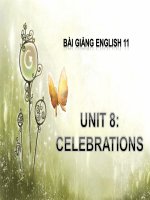Bài giảng Tiếng Anh 11 - Unit 9: The post office (Language focus)
Bạn đang xem bản rút gọn của tài liệu. Xem và tải ngay bản đầy đủ của tài liệu tại đây (1.92 MB, 20 trang )
Po s t o ffic e
( Language Focus)
/ sp / / st / / sk /
/ sp / / st / / sk /
Speak[spi:k]
Speech[spi:t∫ ]
Speedy['spi:di]
Crisp[krisp]
Spacious['spei∫ə
s]
Stanley[stænli:]
Stand[stænd]
Stop[stɔp]
Best[best]
Text[tekst]
Ask[ɑ:sk]
Disk[disk]
Dusk[dʌsk]
Skill[skil]
school[sku:l]
/ sp / / st / / sk /
Practise the dialogue, paying
attention to the red words
Practise the dialogue, paying attention
to the red words
A:Ladies and gentlemen …
B:Speak up, Stanley!
A:I stand before you.
B:Speak up, Stanley!
A:On this School Speech Day …
B:Do speak up!
A:ON THIS SCHOOL SPEECH DAY
Practise the dialogue, paying attention
to the red words
B:Stop shouting, Stanley!
A:And I speak for both my wife and
myself, when I say …
B:Speak up, Stanley!
A:SPEAK UP, STANLEY!!!
1. What do you call a person who designs building?
an architect
2. What do you call a person who buys things from a
shop?
a customer
3. What do you call a person who flies a plane?
a pilot
4. What do you call a person that takes photographs?
a photograph
5. What do you call a thing, which opens a bottle?
bottle-opener
Explain what the words
below mean, using the
phrases from the box.
Explain what the words below mean,
using the phrases from the box.
1. a burglar is someone who breaks into the
house to steal things.
2. a customer is someone who buys things from
the shop.
3. a shoplifter is someone who steals things
from the shop.
4. a coward is someone who is not brave .
5. a tenant is someone who pays rent to live
in a house or a flat.
How many clauses are there in the sentence?
Relative Clauses
(Defining relative clauses and non-defining relative
clauses)
Defining relative clauses
Non-defining relative clauses
Defining relative
clauses
Non-defining
relative
clauses
- Cần thiết cho ý nghĩa của câu.
- Không ở giữa hai dấu phẩy.
- Có chức năng như một tính từ.
- Bắt đầu WHO, WHOM, WHICH thay bằng THAT.
- Bắt đầu WHOSE thay bằng OF WHICH.
- Không cần thiết cho ý nghĩa của câu.
- Loại bỏ mệnh đề tính từ không hạn định, mệnh đè chính vẫn
đầy đủ ý nghĩa.
- Mệnh đề tính từ không hạn định thường ở giữa hai dấu phẩy.
- Bắt đầu WHO, WHOM, WHICH không bao giờ thay bằng THAT.
1. A pacifist is a person ………
who believes that all wars
are wrong.
2. An orphan is a child …………
whose parents are dead.
whom I met
3. I don’t know the name of the woman ……..…
yesterday.
4. This school is only for children ………..…
whose first
language is not English.
5. The woman ………...
whom I wanted to see was on
holiday.
1. The man answered the phone. He told me you were away.
The man …………………………………………..
who answered the phone told me you were away.
2. A waitress served us. She is very impolite and impatient.
………………………………………………………
The waitress who served us was very impolite and impatient.
3. A building was destroyed in the fire. It has been now
rebuilt.
The building which was destroyed in the fire has now been rebuilt.
…………………………………………………….
4. Some people were arrested. They have been now released.
The people who were arrested have now been released.
…………………………………………………….
5. A bus goes to the airport. It runs every half an hour.
HOMEWORK
1.Do exercises 1, 2, 3,4 in your
textbook on pages 109, 110.
2. Prepare the next lesson:
Unit 10 Speaking.
Re me mbe r to do
yo ur ho me wo rk!









